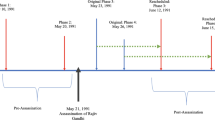Abstract
In US presidential elections, voters in noncompetitive states seem not to count—and have zero power, according to standard measures of voting power—because they cannot influence the outcome in their states. But the electoral votes of these states are essential to a candidate’s victory, so they do count, but in a different way. We propose a simple model that enables us to measure the setup power of voters in noncompetitive states by modeling how these states structure the contest in the competitive states, as illustrated by the 2012, 2008, 2004, and 2000 presidential elections. We define three measures of setup power—winningness, vulnerability, and fragility—and show how they pinpoint the advantages of the candidate who leads in electoral votes of noncompetitive states. In fact, this candidate won in all four elections.
Similar content being viewed by others
Notes
In another election (1824), no majority electoral-vote winner emerged, so the election was decided in the House of Representatives. However, because electors in six states were appointed legislatively rather than elected popularly, one cannot determine who the popular-vote winner was (Andrew Jackson received a plurality of electoral votes but lost the election to John Quincy Adams in the House).
Fairvote.org (2016) reported, based on data compiled by the Washington Post, that in the 2012 presidential election, ten states it identified as “battleground” (or competitive) received 99.6 % of the money spent on advertising by the major-party campaigns and their allies. For an even more dramatic comparison, consider two adjacent New England states, New Hampshire (a battleground state) and Vermont (a Democratic state). National Public Radio (2016) reported that, in 2012, New Hampshire received 1000 times more presidential campaign spending per capita than Vermont.
The last presidential election in which a third-party candidate won any electoral votes was 1968, when George Wallace, who garnered 13.5 % of the national popular vote, received a plurality of popular votes in five southern states and, therefore, all of their electoral votes. In 1992, Ross Perot won a larger proportion of the national popular vote (18.9 %) but failed to win any states or electoral votes.
Standard measures of voting power, such as the Shapley–Shubik index (1954) or the Banzhaf index (1965, 1968), would say that voters in these states have no voting power because they will never be pivotal—they will always vote for one party. For comprehensive information on measures of voting power, see Felsenthal and Machover (1998) and Holler and Nurmi (2013). The focus of these measures is on minimal winning coalitions, from which the defection of a player would cause the coalition to be losing, whereas our measures take into account all winning coalitions.
As we show in Sect. 4, in 2004 and 2000 there were 12 and 16 competitive states, respectively, producing a dramatic increase in the number of possible splits to 4096 and 65,536.
Our measures are related to two measures proposed in Coleman (1971)—the “power to initiate action” and the “power to prevent action”—where the action in our case is winning the election. Our three measures, unlike Coleman’s, are tailored specifically to capture the effects of winner-take-all in the Electoral College; they cannot be derived from Coleman’s.
An exactly even split of partisan voters between the two parties will almost never occur, so it is more accurate to say that the split is within some margin of error of being 50–50.
In the case of a tie in the Electoral College, or if no candidate wins a majority of electoral votes because of a split among more than two candidates, the election is decided by a simple majority in the House of Representatives, wherein each state has one vote, as was formalized by the 12th Amendment (1804).
For all four presidential elections we analyze, we developed Excel spreadsheets to calculate our three measures of setup power, using both 6 and 3 % criteria to be competitive (see Sect. 5).
In general, we define q to be the probability that the value of the random variable deviates from the mean by at least as much as was actually observed.
The accuracy of state polls has increased since 2000, enabling Nate Silver to predict correctly the election outcomes in all 50 states in 2012 (http://en.wikipedia.org/wiki/Nate_Silver).
References
Banzhaf, J. F., III. (1965). Weighted voting doesn’t work: A mathematical analysis. Rutgers Law Review, 19(2), 317–343.
Banzhaf, J. F., III. (1968). One man, 3.312 votes: A mathematical analysis of the Electoral College. Villanova Law Review, 13(2): 304–332.
Brams, S. J., & Davis, M. D. (1974). The 3/2’s rule in presidential campaigning. American Political Science Review, 68(1), 113–134.
Coleman, J. S. (1971). Control of collectivities and power of a collectivity to act. In B. Lieberman (Ed.), Social choice. New York: Gordon and Breach.
Fairvote.org (2016). Following the money: Campaign donations and spending in the 2012 presidential race. http://www.fairvote.org/2012chart. Accessed 12 September 2016.
Felsenthal, D. S., & Machover, M. (1998). The measurement of voting power: theory and practice, problems and paradoxes. Cheltenham, UK: Edward Elgar.
Holler, M. J., & Nurmi, H. (Eds.). (2013). Power, voting, and voting power: 30 years after. Berlin: Springer.
Myerson, R. B. (1993). Incentives to cultivate favored minorities under alternative electoral systems. American Political Science Review, 87(4), 856–869.
National Public Radio (2016). A campaign map, morphed by money. http://www.npr.org/sections/itsallpolitics/2012/11/01/163632378/a-campaign-map-morphed-by-money. Accessed 12 September 2016.
Roberson, B. (2006). The Colonel Blotto game. Journal of Economic Theory, 29(1), 1–24.
Shapley, L. S., & Shubik, M. (1954). A method for evaluating the distribution of power in a committee system. American Political Science Review, 48(3), 787–792.
Acknowledgments
We are grateful to Nicholas R. Miller, an anonymous referee, and the editors, William F. Shughart II and Keith Dougherty, for valuable comments.
Author information
Authors and Affiliations
Corresponding author
Rights and permissions
About this article
Cite this article
Brams, S.J., Kilgour, D.M. Paths to victory in presidential elections: the setup power of noncompetitive states. Public Choice 170, 99–113 (2017). https://doi.org/10.1007/s11127-016-0386-8
Received:
Accepted:
Published:
Issue Date:
DOI: https://doi.org/10.1007/s11127-016-0386-8




